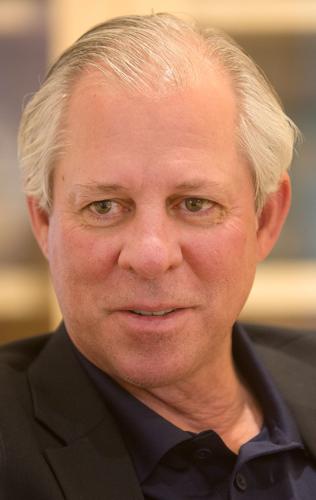The University of Arizona’s senior health administrator has added more than $150,000 to his executive pay by moonlighting as a consultant to numerous for-profit medical firms, public records show.
In the 18 months since Dr. Michael Dake was hired at a salary of $875,000 a year to lead the UA’s medical enterprise, his office has sat empty on a regular basis, sometimes for days at a time, as he traveled the state, the country and the globe working on behalf of at least five companies, an Arizona Daily Star investigation shows.
Dake received 49 payments totaling more than $100,000 in his first six months on the job, according to the most recent public data made available by the federal government. Fifteen of those payments — about $12,000 worth — were for Dake’s out-of-town business trips to consulting gigs in Scottsdale; Flagstaff; Chicago; San Francisco; Stanford, California; and Lisbon, Portugal, records show.
Dake’s work for one corporate client — Cook Medical, based in Bloomington, Indiana — came under federal scrutiny last year because of what one expert called a “shocking” error in Dake’s published research results, the Star found.
While outside consultant work is permissible, it must be disclosed to the school in writing by the employee. Dake violated that policy by not disclosing any of his outside income for his entire first year on the job, the investigation found. He did file disclosures for the current school year that say he expects to make up to $66,000.
Dake reports directly to his longtime friend, UA President Robert C. Robbins, whose decision to hire Dake as senior vice president is the subject of a federal lawsuit. The lawsuit, filed by a former UA health executive, claims Robbins interfered with the executive search process to give Dake the job despite negative feedback from multiple UA search committee members. The UA has strongly denied wrongdoing in the case.
The Star’s investigation also found Robbins bent an Arizona Board of Regents hiring policy to his friend’s benefit — and to the UA’s potential detriment. As well, it found Robbins knew, when he hired Dake at the UA, that Dake had conducted experimental surgeries with fatal consequences at his previous employer, Stanford University.
Robbins and Dake did not respond directly to detailed written questions for this story. Instead, UA marketing and communications chief Steve Moore provided a one-paragraph statement for each of them that defended Dake’s outside work but did not directly answer several of the questions.
“(Dake) has served with distinction as Senior Vice President of Health Sciences for over 18 months following a thorough national search for the position,” the statement said. “An internationally recognized expert in his field, he has significant consultative relationships as a result.”
Federal data
While a complete picture of Dake’s outside work is difficult to assemble because some documents were not available, the Star was able to piece together some of the scope through a federal database and documents obtained through public-records requests.
Spurred by concerns about overly cozy relationships between doctors and the medical industry, the Obama administration set up an online registry called Open Payments, where companies must publicly disclose all payments made to physicians each year.
Since the government began tracking the data in 2013, Dake has received 865 payments worth nearly $2.2 million, primarily for consulting fees, most of it before he was hired at the UA.
In 2018, the most recent year for which data is available, the registry shows Dake received about $230,000 — more than 40% of it after he started work at the UA that June. It also documents the total payments made specifically for business travel and the destinations of his out-of-town trips.
Federal data for 2019 is not yet available and is due to be added to the registry in June. But medical industry websites show Dake has continued his outside work this year. He’s made trips to Las Vegas; Washington, D.C.; Barcelona, Spain; and Leipzig, Germany, to make research presentations for at least one of his corporate clients, according to Cook Medical’s website.
In his first six months at the UA, Dake’s top source of outside income — $69,000 — was from W.L. Gore and Associates. The Delaware-based firm is best known for making Gore-Tex, a waterproof fabric that’s used to make rainwear and also has medical applications.
His second-highest payer — about $19,000 — was Cook Medical, which makes an array of medical products, including stents, catheters and feeding tubes.
Dake was among the 10 highest paid consultants for both companies in 2018. He appears to be the only doctor on either list who serves as a university vice president. His UA duties include oversight of two medical schools — one in Phoenix and one in Tucson— and the UA colleges of nursing, pharmacy and public health.
Faculty concerns
The extent to which Dake’s absences are affecting the UA medical enterprise is unclear.
Jessica Summers, chair of the faculty, said she has “no comment at this time.” The Star also contacted four medical faculty members who declined to comment, either because they signed nondisclosure agreements or feared retaliation by university administration.
A UA doctor who agreed to be interviewed on condition of anonymity reported “a real decrease in morale” since Dake arrived. “He’s just not present. Visibility builds credibility and credibility builds trust, and he is not trusted.”
Steven Schwartz, a regents professor of chemistry and biochemistry at the UA, said the level of unhappiness among medical faculty is well-known outside the medical school.
“Like many senior faculty on campus, and I’m sure administrators for that matter, I am extremely concerned regarding both the current situation and the future of our College of Medicine,” he said.
Delays and denial
When attempting to document Dake’s consulting work through public-records requests, the Star faced delays and the wrongful denial of certain documents.
The Star made a request last fall to see whether Dake had filed written disclosure forms for his outside work, as required by UA policy, but was told the documents didn’t exist.
That changed last week when the school produced disclosure forms, dated more than a year after Dake’s hiring, that cover the current school year. But none of those documents covered 2018, the year Dake earned more than $100,000 from his outside jobs during his first six months at the UA.
The UA said Friday that it has no record of Dake filing disclosure forms in 2018. The school’s initial failure to turn over his 2019 disclosures was due to a “miscommunication,” an official said.
The Star also requested copies of Dake’s office calendars to assess how often he is away from campus. Three months later the UA has been unable to produce those records. Moore did not give a reason for the delay, but said it’s taken “longer than expected.”
In the limited financial disclosures the UA provided, Dake estimated he would earn up to $66,000 in current school year from three companies — W.L. Gore, Cook Medical, and Bard Medical, a Georgia-based medical devices company.
Dake, in his statement, said his consulting work is “connected directly to my experience, education and success in my field.” He said he looks forward “to working relentlessly with my talented team” to position the UA’s medical enterprise for future success.
5-year job offer
Dake received exclusive treatment from Robbins in the form of a written five-year job offer, an action that could potentially put the university in legal trouble, according to a Tucson employment attorney who reviewed UA policy and the signed documents.
The UA president offered Dake a minimum base salary of $875,000 a year for five years — about $4.4 million in total — even though Dake doesn’t qualify for a five-year employment deal under regents policy, records show. The offer included his appointment as both a UA administrator and a faculty member.
Arizona Board of Regents’ policy for the state’s three public universities says administrative appointments “shall not be for more than one fiscal year,” while faculty appointments limit multiyear contracts to “no more than three academic or fiscal years.”
Attorney Merle Joy Turchik said Robbins’ five-year offer puts the UA at potential risk for financial liability in the event of a job-related dispute between the school and Dake.
“If President Robbins wanted to give someone a five-year contract, he should have asked the regents to change the policy,” she said.
The offer letter states “UA will maintain your base salary at least at $875,000 for the first five years of your employment should you remain in good standing.”
But Julie Newberg, a regents spokeswoman, contended that it did not violate policy because the language referring to the five-year offer was preceded by a statement that the UA is "unable to offer you a multi-year contract due to Arizona Board of Regents policy."
"The letter does not offer a five-year term and explicitly states that Dr. Dake’s appointment was on a year-to-year basis," Newberg said in a prepared statement.
Turchik said the language shows the "university is trying to leave itself the legal out it needs," but she said, in her opinion, "it opens them to litigation that is unnecessary."
"It appears to contravene the policy and certainly it doesn't seem like it's following the spirit of the policy," she said.
Dake was the only member of the UA’s senior leadership team to receive a multiyear job offer, according to the Star’s review of the six senior vice presidents hired by Robbins. A further review found Dake and Moore’s offer letters were the only two to not include an addendum alerting them that “significant financial interests” must be disclosed within 30 days of hire.
Though Dake’s base salary is $875,000, his total UA compensation was $928,734 last year once health and retirement benefits were added to his wages, records show.
Research error
Dake’s work for Cook Medical raised alarm bells at the U.S. Food and Drug Administration last year.
The work involved a clinical trial he led on Cook’s behalf for a new type of stent, a tubelike device used to unblock clogged arteries in patients with pulmonary artery disease. This particular stent, the Zilver PTX, is coated with a chemotherapy drug, paclitaxel, that releases gradually to prevent scar tissue from reblocking the arteries.
Dake’s published research incorrectly reversed the study’s five-year mortality figures, making it seem as if the Zilver stent had a lower risk of patient death (10.2%) than a comparable uncoated device (16.9%). He published a correction to his initial results in the medical journal Circulation last year.
The flawed findings were initially published in 2016 before Dake’s UA tenure. It came to light only in late 2018 when Greek researchers published a meta-analysis that found a higher death rate for patients treated with coated devices at two years and five years after treatment.
“The findings shocked the vascular community,” said an article in the July 2019 edition of the Journal of Vascular Surgery.
A national expert in medical device research interviewed by the Star called the death-rate error “humiliating” for any medical researcher to have on their record. Dake was ultimately responsible, as the study’s global principal investigator, for ensuring the published findings were accurate, said Diana Zuckerman, president of the National Center for Health Research in Washington, D.C.
The mistake “shows a level of sloppiness or incompetence that is shocking,” said Zuckerman, who often testifies before Congress and the FDA on the safety of drugs and medical devices.
Dake did not respond to questions about the controversy.
The Zilver PTX stent is still on the market, but the FDA has advised doctors to consider alternatives, to closely monitor patients who have already have the stents, and to clearly alert patients to the death risk before deciding on the benefits of treatment. The federal agency also has called for further research to investigate the cause of the higher mortality findings.
In a prepared statement, a spokeswoman for Cook Medical expressed confidence the stent was meeting requirements for “safety and effectiveness.”
“Dr. Dake is the principal global investigator for a clinical program that has collected and analyzed Zilver PTX data through 185 clinical sites, treating more than 2,500 patients around the world,” the statement said.
SURGERY SCANDAL
In the news release announcing Dake’s hiring, the university hailed him as “an internationally recognized physician-scientist, health educator and innovative medical researcher.”
It said Dake holds 31 U.S. patents, has founded five companies and has written more than 300 peer-reviewed articles, making him “one of the top scientists in his field.”
“Mike is a pioneer, recognized internationally in the field of interventional radiology, with whom I was privileged to work for over two decades at Stanford University,” Robbins said at the time.
What was not said is that Dake conducted experimental surgeries on multiple sclerosis patients that resulted in Stanford having to settle lawsuits filed by patients.
One patient died and at least two others were injured in 2009 when Dake implanted artery stents in their veins on the unproven theory that doing so could ease MS symptoms by improving blood flow to the brain.
One MS patient needed emergency surgery when a stent broke loose and lodged in his heart, and another died of a brain hemorrhage shortly after the procedure. Stanford settled out of court with two patients who sued.
At the time, Robbins was chair of cardiothoracic surgery at Stanford and Dake was a professor of cardiothoracic surgery, Star research shows.







